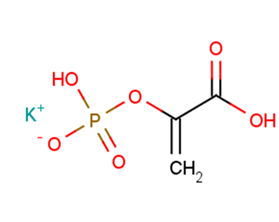
Phospho(enol)pyruvic acid monopotassium
CAS No. 4265-07-0
Phospho(enol)pyruvic acid monopotassium( PEP-K )
Catalog No. M19765 CAS No. 4265-07-0
Phosphoenolpyruvic acid monopotassium salt is involved in glycolysis and gluconeogeneis. In glycolysis PEP is metabolized by Pyruvate Kinase to yield pyruvate. In plants PEP is involved in the formation of aromatic amino acids as well as in the carbon fixation pathway.
Purity : >98% (HPLC)
 COA
COA
 Datasheet
Datasheet
 HNMR
HNMR
 HPLC
HPLC
 MSDS
MSDS
 Handing Instructions
Handing Instructions
| Size | Price / USD | Stock | Quantity |
| 100MG | 35 | In Stock |


|
| 200MG | 50 | In Stock |


|
| 500MG | Get Quote | In Stock |


|
| 1G | Get Quote | In Stock |


|
Biological Information
-
Product NamePhospho(enol)pyruvic acid monopotassium
-
NoteResearch use only, not for human use.
-
Brief DescriptionPhosphoenolpyruvic acid monopotassium salt is involved in glycolysis and gluconeogeneis. In glycolysis PEP is metabolized by Pyruvate Kinase to yield pyruvate. In plants PEP is involved in the formation of aromatic amino acids as well as in the carbon fixation pathway.
-
DescriptionPhosphoenolpyruvic acid monopotassium salt is involved in glycolysis and gluconeogeneis. In glycolysis PEP is metabolized by Pyruvate Kinase to yield pyruvate. In plants PEP is involved in the formation of aromatic amino acids as well as in the carbon fixation pathway.
-
In Vitro——
-
In Vivo——
-
SynonymsPEP-K
-
PathwayOthers
-
TargetOther Targets
-
RecptorOthers
-
Research Area——
-
Indication——
Chemical Information
-
CAS Number4265-07-0
-
Formula Weight206.13
-
Molecular FormulaC3H4KO6P
-
Purity>98% (HPLC)
-
SolubilityDMSO:10 mM
-
SMILES[K+].OC(=O)C(=C)OP(O)([O-])=O
-
Chemical Name——
Shipping & Storage Information
-
Storage(-20℃)
-
ShippingWith Ice Pack
-
Stability≥ 2 years
Reference
molnova catalog



related products
-
2-Methoxyflavone
2'-Methoxyflavone is a bioactive chemical.
-
N-phenethylbenzamide
N-phenethylbenzamide is a natural product.
-
N-Acetyl-L-histidine...
N-Acetyl-L-histidine monohydrate (NAH) also exhibits a strong phylogenetic component in that it is a major osmolyte in the brain and eye of teleost (bony) fish, amphibians and reptiles, but is present in much lower amounts in brain and other tissues of homeothermic (endothermic) vertebrates.



 Cart
Cart
 sales@molnova.com
sales@molnova.com


